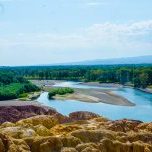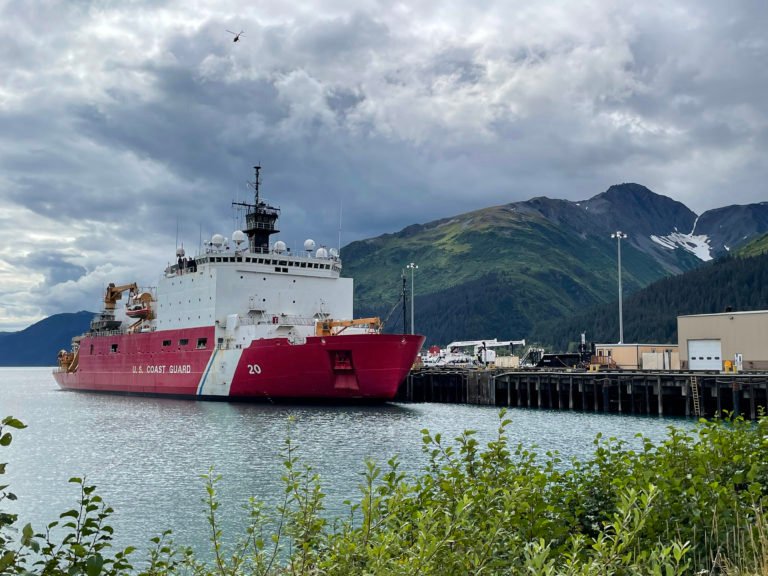Stockholm, Aug. 27(ChinaEuropeDialogue)–The U.S. Coast Guard aims to conduct scientific research while also training crew and asserting a presence in an increasingly competitive region.By Melody Schreiber -August 26, 2021。

A U.S. Coast Guard icebreaker embarked Wednesday on a long Arctic mission that includes a rare transit of the Northwest Passage, conducting scientific research and a joint exercise with Canada in Arctic waters.
The cutter Healy, one of two operational U.S. Coast Guard icebreakers, departed Wednesday from Seward, Alaska, for the three-week journey to Nuuk, Greenland.
The U.S. and Canadian coast guards will conduct a joint search-and-rescue exercise nearResolute, Nunavut, on September 6 and 7, Jason Kung, a spokesperson for Global Affairs Canada, told ArcticToday in an email.
It is the first planned international engagement of Healy’s deployment, Lieutenant Commander Gregory Carr, a spokesperson for the U.S. Coast Guard, told ArcticToday.
Last year, a catastrophic fire cut short Healy’s Arctic patrol. A new engine was shipped from Baltimore and successfully installed. So far, the ship is working very well, Carr said.
Healy last transited the passage in 2005.
In 2017, the U.S. cutter Maple navigated the Northwest Passage from west to east together with the Canadian icebreaker Terry Fox to conduct research in a joint exercise with Canada.

Conducting research and projecting presence
U.S. vessels may travel through the passage if they are conducting research, according to a 1988 agreement with Canada.
Scientists will map the seafloor, a task that will improve navigation maps and scientific models of how water and ice in the passage behave, and they will also observe how the ocean, atmosphere, ice and land interact.
“There was a call that the ship will be heading through the Northwest Passage, and there was a call for science that can take advantage of passage,” Dr. Larry Mayer, lead scientist on the mission and founding director of the Center for Coastal and Ocean Mapping at the University of New Hampshire, told ArcticToday. “They wanted to bring the vessel to Greenland, and made the vessel available.”1 of 3

In addition to the scientific work, the Healy crew will learn how to operate within the passage.
The voyage is “showing that the U.S. will keep a presence in the Arctic and maintain our sovereignty. At the same time, we’re learning and improving our capabilities,” Carr said.
The service conducts “all missions simultaneously,” including national security and science, he said.
Vice Admiral Steven D. Poulin, commander of the Atlantic area, described these simultaneous priorities in an online presentation last week as “not a matter of taking off one hat and putting on another hat — we wear those hats all at the same time.”
Poulin said the Arctic is “becoming increasingly competitive” as it opens to more traffic and potential resource extraction, but he lauded collaboration with international partners.
The Healy transit is “an outstanding opportunity to showcase the Coast Guard’s operability in the Atlantic and a chance for us to continue to build partnerships with Arctic nations, especially Canada and Denmark,” Poulin said.
The U.S. previously floated the idea of a controversial freedom of navigation operation through the passage, but this voyage will not be a FONOP, Carr said. “We are partners with Canada as we go through the Northwest Passage,” he said.
The invocation of the 1988 agreement on Arctic cooperation means Canadian-U.S. relations are “returning back to normality,” Rob Huebert, assistant professor at the University of Calgary, told ArcticToday.
The science part of the mission is crucial for upholding that agreement, Huebert said. “Consent is associated with the scientific regime,” he said. The U.S. can tell Canada, “I want your country’s consent to go through your waters to engage upon scientific activity,” he said. (While the U.S. sees the passage as international waters, Canada regards it as internal waters.)
The Coast Guard first approached Canada to request consent in summer 2020, Kung said, and Canadian and U.S. agencies have worked together closely on the trip.

Healy left its homeport of Seattle on July 10 and arrived in Dutch Harbor nine days later. It departed on July 22 for nearly a month of ice trials in the Chukchi Sea.
About 15 scientists boarded the ship in Seward. Healy does not plan to stop along the way to collect samples or data, making it unusual among scientific missions. “The science that’s going to be done is science that can be done underway,” Mayer said.
Because of COVID-19 restrictions, Mayer said, the scientific expedition is limited to U.S. scientists, though there is close international collaboration.
“Data collected on this mission will be freely shared with Canadian counterparts,” Kung said. “Canada and the U.S. share a desire to protect our sensitive northern environments and enjoy strong bilateral cooperation in Arctic scientific research.”
The crew has officers from the U.S. Coast Guard and the U.S. Navy, as well as from Canadian Coast Guard, Canadian Navy, the Dutch Navy and the British Royal Navy, Carr said.

The planned engagement in September near Resolute will also involve the Canadian Rangers, part of the country’s armed forces, he said.
The Canadian icebreaker Des Groseilliers will join Healy to gain experience working together on search and rescue, which could become more common as the passage sees more cruise ship traffic.
Canada is also staging a month-long exercise, Operation Nanook, in Arctic waters.
Two U.S. Coast Guard cutters, which are not ice-capable, recently joined that exercise near Greenland, Poulin said.
“Historically, it has only been our icebreakers that have operated in the high latitudes,” Poulin said. “We have built up a capability throughout the course of our history, but that capability has been limited to a very, very small segment of the Coast Guard, and that’s our icebreaker fleet.”
Since the U.S. only has two operational icebreakers in its fleet, Poulin said, the service is “trying to push other cutters farther north, working with other countries to showcase how we can operate a wider breadth of Coast Guard capability in the high latitudes.”1 of 4

‘Perfect opportunity’ for science
Dr. Jeffrey Welker, a scientist with a joint appointment with the University of Alaska Anchorage and the University of Oulu, Finland, invoked the Franklin Expedition of the 1840s in which navigators searched for new trade routes.
“We’re traveling through some very historic waters in the Arctic, some of the most historic waters of the entire Arctic,” Welker, who is on the transit, told ArcticToday.
These waters may soon see more commerce in them. With climate change, Welker said, they are very different from what explorers encountered a century and a half ago.
The scientists aboard Healy are particularly interested in ice loss in Greenland and in the Canadian Arctic, which has cascading effects: more freshwater discharge from rivers, new land exposed as the ice recedes, thawing permafrost in that land that releases carbon into the water.
These changes affect the food systems that support life in the Arctic, Welker said. “These biogeochemical changes are controlling the distribution and the characteristics of food webs, which then are influencing the societies that live there,” he said. “This is really one of the places where the rubber really hits the road.”
In Greenland, some researchers will disembark and others will join the mission. The ship is expected in Nuuk in mid-September.
Scientists will also examine ocean currents around the Arctic island. “The North Atlantic current is digging deeper and deeper into the Arctic,” Welker said. They will examine the ways the currents surround Greenland — how they expand, how they change, how they influence and transport heat and energy in these “critical” regions of the Arctic, he said.1 of 2

Mayer, the chief scientist, has been working on dual projects to map the U.S. exclusive economic zone and to map the entire seafloor. “It was a perfect opportunity for us from a mapping perspective to take advantage of the passage,” he said. “This is an area that’s always difficult to get to and it is relatively unmapped.”
Along the Alaska coast, Mayer will work with the Coast Guard to focus on filling mapping gaps, charting a route to add to U.S. EEZ knowledge. Canadian and Greenland colleagues have suggestions for further mapping.
“We’re going to try to hit some of their high-priority gaps, without the ship diverting too much from its standard route, because it doesn’t have a lot of extra time,” Mayer said. “So much of the seafloor is unmapped that you don’t have to look far to find the places not mapped.”
As traffic increases in the Arctic, “one of the real key issues is as simple as safety of navigation,” Mayer said. Understanding the seafloor could help ships keep from running aground in a perilous region.
Mapping the seafloor will also help scientists understand how currents flow, how sediment is transported, and what happens with storm runoff.
“The more we know about the nature of the seafloor, the more we can do those kinds of predictions,” Mayer said.
He compared scientific modeling of the sea to weather modeling. “Think about trying to do a weather forecast when you don’t know if the Rocky Mountains are there,” Mayer said.
Climate change as a major security issue
The transit to Nuuk, and the weeks of research around the island, point to the growing relationship between the U.S. and Greenland.
The voyage also helps the Coast Guard prepare for increasing risks from a changing climate, Carr said. With a new heavy icebreaker planned to come online in 2024, the voyage will help prepare service members for Arctic work.
“We are making plans now to position ourselves to be a ready and relevant force into the future,” Carr said.1 of 4

After it departs Greenland, Healy plans several East Coast port calls, including Boston in mid-October and possibly Baltimore. The ship will then circumnavigate North America, passing through the Panama Canal and returning to Seattle around Thanksgiving.
In December, the Polar Star ventured the farthest north a U.S. surface vessel has ever gone in wintertime. Those were “truly varsity-level operations” providing invaluable experience for crew members, commanding officer Capt. William Woityra told ArcticToday.
While the U.S. Coast Guard members usually cycle through different deployments around the world, their Canadian counterparts may gain decades of specialized Arctic experience, Huebert said.
“It’s an exacting art, it’s not something that’s easy, it can’t be something taught in the classroom, and it is something that is expensive,” he said. “For ice services, you typically have to have that expertise. That’s one of the critical parts.”


